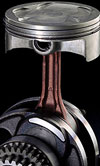Alternatives to DLC
 Whilst DLC seems clearly to be the favourite coating at the moment, there are some applications where it isn’t necessarily favoured, for various reasons.
Whilst DLC seems clearly to be the favourite coating at the moment, there are some applications where it isn’t necessarily favoured, for various reasons.
One area where ‘traditional’ DLC coatings have struggled is in applications where temperatures are significant. The DLC coating begins to degrade at quite a low temperature in comparison with other coatings, such as titanium nitride (TiN) for example. Many of the more common and traditional coatings were developed years before DLC and were used initially as tool coatings for the manufacturing industry. Common examples of this are coated shear and press tools for sheet metal manufacturing and, of course, the almost ubiquitous coated drill bits which we now find. Milling tools are another popular application of coatings, both on traditional cutters and those with interchangeable machining inserts.
The types of coatings that we find on milling cutters are suitable, in some cases, for applications where temperatures exceed 1000 degrees C (1832 degrees F). Widely available data from coating suppliers shows us that those coatings based on aluminium chromium nitride (AlCrN) can withstand temperatures of 1100 degrees C. However, data from the same source states a maximum temperature of 300 – 350 degrees C (approximately 570 – 660 F) for the carbon based coatings such as DLC and tungsten carbide/carbon (WC/C). Unfortunately, with those coatings such as AlCrN, we find that the coefficient of friction is not as low as the DLC coatings.
You might ask what applications, besides those in the exhaust flow or combustion chamber, experience temperatures in excess of 300 degrees C in an engine. Where very high contact pressures are present, in combination with high sliding velocities, the temperature developed in the contact can become very high, and this can lead to degradation and failure of the coating. These ‘flash temperatures’, if excessive, can lead to tempering and consequent decreases in mechanical properties of the underlying material. In addition to the very welcome decrease in measured friction, the avoidance of high flash temperatures in heavily-loaded sliding contacts is one of the reasons why coatings were used in these applications in the first instance. For example, finger followers, used with the extreme valve opening accelerations in Formula One, will not survive without low-friction coatings, and the limitation on the coating is due to flash temperatures in the contact area. So, there is pressure on coating suppliers to develop low-friction coatings which have a higher service temperature limit.
Of course, there are applications where we can expect temperatures to exceed 300 degrees C. Valves are an obvious example, and on these components we might find coatings such as TiN and chromium nitride (CrN) much more commonly that we would find DLC, although some coating suppliers now coat valves with DLC. The area of valves which are most commonly coated, if they are not coated all over, are the valve seat surface and the stem. Valve seat coatings can help prevent wear of both the valve and the seat insert. We should note that, for coated valves, we should not lap the valves to the head in the traditional method, because we can easily destroy the coating that we have just paid for.
Written by Wayne Ward.